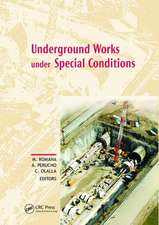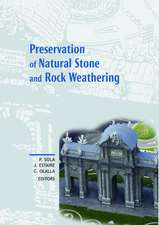Finite Element and Boundary Methods in Structural Acoustics and Vibration
Autor Noureddine Atalla, Franck Sgarden Limba Engleză Paperback – 26 iul 2017
Finite Element and Boundary Methods in Structural Acoustics and Vibration provides a unique and in-depth presentation of the finite element method (FEM) and the boundary element method (BEM) in structural acoustics and vibrations. It illustrates the principles using a logical and progressive methodology which leads to a thorough understanding of their physical and mathematical principles and their implementation to solve a wide range of problems in structural acoustics and vibration.
Addresses Typical Acoustics, Electrodynamics, and Poroelasticity Problems
It is written for final-year undergraduate and graduate students, and also for engineers and scientists in research and practice who want to understand the principles and use of the FEM and the BEM in structural acoustics and vibrations. It is also useful for researchers and software engineers developing FEM/BEM tools in structural acoustics and vibration.
This text:
- Reviews current computational methods in acoustics and vibrations with an emphasis on their frequency domains of applications, limitations, and advantages
- Presents the basic equations governing linear acoustics, vibrations, and poroelasticity
- Introduces the fundamental concepts of the FEM and the BEM in acoustics
- Covers direct, indirect, and variational formulations in depth and their implementation and use are illustrated using various acoustic radiation and scattering problems
- Addresses the exterior coupled structural–acoustics problem and presents several practical examples to demonstrate the use of coupled FEM/BEM tools, and more
| Toate formatele și edițiile | Preț | Express |
|---|---|---|
| Paperback (1) | 575.51 lei 6-8 săpt. | |
| CRC Press – 26 iul 2017 | 575.51 lei 6-8 săpt. | |
| Hardback (1) | 1557.45 lei 6-8 săpt. | |
| CRC Press – 17 apr 2015 | 1557.45 lei 6-8 săpt. |
Preț: 575.51 lei
Preț vechi: 677.06 lei
-15% Nou
Puncte Express: 863
Preț estimativ în valută:
110.14€ • 114.56$ • 90.92£
110.14€ • 114.56$ • 90.92£
Carte tipărită la comandă
Livrare economică 14-28 aprilie
Preluare comenzi: 021 569.72.76
Specificații
ISBN-13: 9781138749177
ISBN-10: 1138749176
Pagini: 472
Ilustrații: 172
Dimensiuni: 156 x 234 x 24 mm
Greutate: 0.65 kg
Ediția:1
Editura: CRC Press
Colecția CRC Press
ISBN-10: 1138749176
Pagini: 472
Ilustrații: 172
Dimensiuni: 156 x 234 x 24 mm
Greutate: 0.65 kg
Ediția:1
Editura: CRC Press
Colecția CRC Press
Cuprins
Introduction. Basic equations of structural acoustics and vibration. Integral formulations of the problem of structural acoustics and vibrations. The finite element method: An introduction. Solving uncoupled structural acoustics and vibration problems using the finite-element method. Interior structural acoustic coupling. Solving structural acoustics and vibration problems using the boundary element method. Problem of exterior coupling. Conclusion. References.
Notă biografică
Noureddine Atalla is a professor in the Department of Mechanical Engineering (Université de Sherbrooke). He is also a member and past director of GAUS (Group d’Acoustique et de vibration de l’Universite de Sherbrooke). Professor Atalla received an MSC in 1988 from the Université de Technologie de Compiègne (France) and a PhD in 1991 in ocean engineering from Florida Atlantic University (USA). His core expertise is in computational vibroacoustics and modeling and characterization of acoustic materials. He has published more than 100 papers and is also the co-author of a book on the modeling of sound porous materials.
Franck Sgard is team leader of the mechanical and physical risk prevention group at the Institut Robert Sauvé en Santé et Sécurité du Travail (IRSST) in Montreal (Canada). He graduated from Ecole Nationale des Travaux Publics de l’Etat (ENTPE) in Vaulx en Velin (France) as a civil engineer in 1990. He obtained his master’s degree in mechanical engineering from the University of Washington (Seattle) in 1991. In 1992 and 1993, he worked as a research assistant in the acoustic group of the University of Sherbrooke (GAUS). He then started a joint PhD (University of Sherbrooke/Institut National des Sciences Appliquées in Lyon, France) in mechanical engineering (acoustics), which he completed in 1995. From 1995 till 2006, he worked as a professor at ENTPE, teaching acoustics
Franck Sgard is team leader of the mechanical and physical risk prevention group at the Institut Robert Sauvé en Santé et Sécurité du Travail (IRSST) in Montreal (Canada). He graduated from Ecole Nationale des Travaux Publics de l’Etat (ENTPE) in Vaulx en Velin (France) as a civil engineer in 1990. He obtained his master’s degree in mechanical engineering from the University of Washington (Seattle) in 1991. In 1992 and 1993, he worked as a research assistant in the acoustic group of the University of Sherbrooke (GAUS). He then started a joint PhD (University of Sherbrooke/Institut National des Sciences Appliquées in Lyon, France) in mechanical engineering (acoustics), which he completed in 1995. From 1995 till 2006, he worked as a professor at ENTPE, teaching acoustics
Recenzii
"…the analyses presented begin with well-known fundamental equations and follow a logical progression to the final solutions. …The book provides a thorough treatment of the theory that underpins FEA and BEA as applied to the solution of vibro-acoustic problems and as such it is a valuable text book for graduate students majoring in acoustics or vibration."
—Colin Hansen, University of Adelaide, Australia
"The approach serves well for researchers of all levels in vibro-acoustics, since the examples provided cover a full spectrum of applications, as well as coupling the examples with the constraints and convergence aspects of FEM that often cause the user to not use the FEM successfully."
—Noise Control Engineering Journal, September-October 2015
"This book paves the way for the curious researcher on their often meandering journey. …the authors encourage the reader to think about the various simplifications and assumptions that have been made in the case examples presented; an essential stepping stone for both the junior and senior researcher. This book fills a great need to provide the essential basis for anyone who may be required to use finite element methods and especially boundary element methods in structural acoustics."
—Dr Andrew Peplow, Noise & Vibration Specialist, Atlas Copco Rock Drills AB
"The book aims to introduce the basic concepts of both the FEM and BEM solution approaches, and the first chapters include some basics of acoustics and vibration. This wide scope poses a challenge in terms of depth vs coverage and some details are by necessity not covered in depth. The book has a distinct value as a point of entry to the covered computational methods and the various aspects involved in their application. However, to be really useful, the reader should have, or be prepared to acquire, a quite thorough understanding and background knowledge in engineering mechanics, mathematics, linear algebra, acoustics and elastodynamics."
—Peter Göransson, Nuntius
"The book contains a rich collection of references and includes MATLAB codes that can readily be used and expanded...I find it very useful and highly recommend it to students and researchers in science and engineering."
-- Ahmad T. Abawi, Chief Scientist, HLS Research, California
—Colin Hansen, University of Adelaide, Australia
"The approach serves well for researchers of all levels in vibro-acoustics, since the examples provided cover a full spectrum of applications, as well as coupling the examples with the constraints and convergence aspects of FEM that often cause the user to not use the FEM successfully."
—Noise Control Engineering Journal, September-October 2015
"This book paves the way for the curious researcher on their often meandering journey. …the authors encourage the reader to think about the various simplifications and assumptions that have been made in the case examples presented; an essential stepping stone for both the junior and senior researcher. This book fills a great need to provide the essential basis for anyone who may be required to use finite element methods and especially boundary element methods in structural acoustics."
—Dr Andrew Peplow, Noise & Vibration Specialist, Atlas Copco Rock Drills AB
"The book aims to introduce the basic concepts of both the FEM and BEM solution approaches, and the first chapters include some basics of acoustics and vibration. This wide scope poses a challenge in terms of depth vs coverage and some details are by necessity not covered in depth. The book has a distinct value as a point of entry to the covered computational methods and the various aspects involved in their application. However, to be really useful, the reader should have, or be prepared to acquire, a quite thorough understanding and background knowledge in engineering mechanics, mathematics, linear algebra, acoustics and elastodynamics."
—Peter Göransson, Nuntius
"The book contains a rich collection of references and includes MATLAB codes that can readily be used and expanded...I find it very useful and highly recommend it to students and researchers in science and engineering."
-- Ahmad T. Abawi, Chief Scientist, HLS Research, California
Descriere
A unique and in-depth presentation of the finite element method (FEM) and the boundary element method (BEM) in structural acoustics and vibrations, this book illustrates the principles using a logical and progressive methodology, which leads to a thorough understanding of their physical and mathematical principles and their implementation to solve a wide range of problems in structural acoustics and vibration. This book helps readers to understand the principles, use of the FEM, and the BEM in structural acoustics and vibrations.














